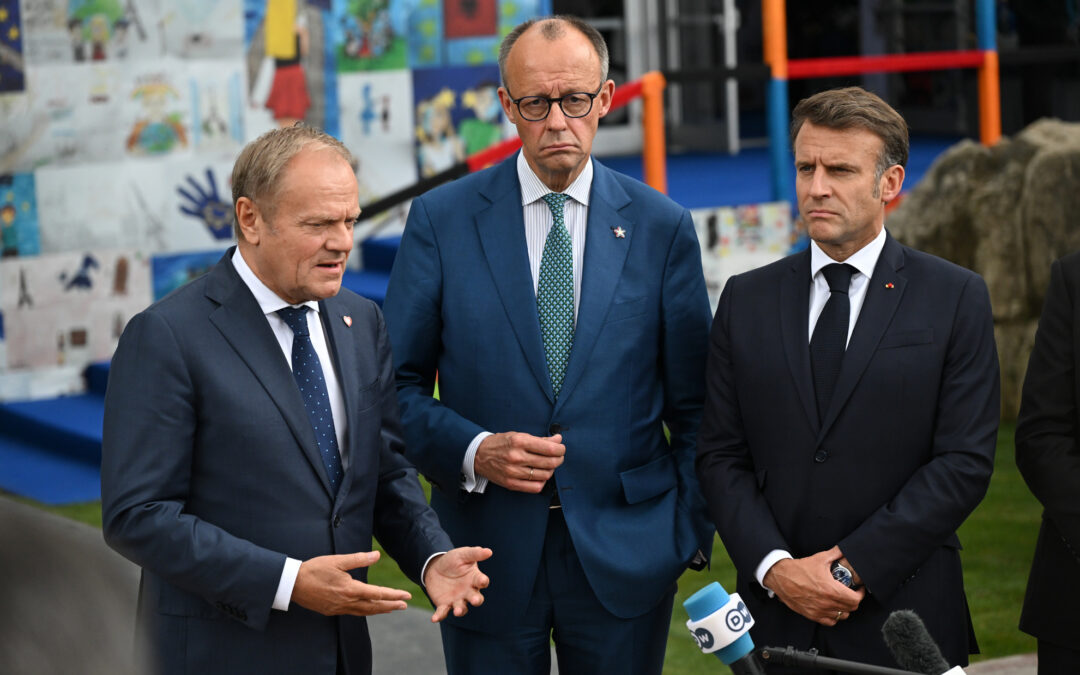By Paweł Wiejski
Twelve years after the last update, the Polish government last week released a new long-term energy strategy. But it was met with a chilly reception. The revamped plan has divided the ruling coalition, while also drawing criticism from both unions for being too tough and green activists for being too soft. Even more problematically, as the EU has set itself more ambitious targets, Poland’s new strategy may already be out of date.
The Polish government’s long-trumpeted “Polish Energy Policy 2040” plan, adopted last week, sets out a strategy to guide Poland’s energy transformation over the next two decades, including reducing its reliance on coal, expanding renewables, and creating the country’s first nuclear power plants.
The aim is to bring Poland’s energy system in line with the European Union’s climate goals by setting targets for greenhouse gas emissions reduction, renewable energy sources, and energy efficiency. It is also meant to tackle Poland’s poor air quality – the worst in the EU – and establish measures to support transition of coal-reliant regions away from fossil fuel.
Poland’s climate minister, Michał Kurtyka, wrote that the new strategy will be “a compass in the area of transition to zero-emission economy”. With a full version of the document expected to be published in the coming days, the details provided so far seem in line with the targets presented in November last year. Yet with the now more ambitious climate goals agreed by the EU in December, Poland is falling out of step with the bloc.
Strategy draws criticism from all sides
The strategy has also proved politically polarising, opening up another rift in the ruling coalition, which has appeared increasingly divided in recent months. Zbigniew Ziobro and Michał Wójcik, ministers from United Poland (Solidarna Polska), the junior coalition partner of the ruling Law and Justice (PiS) party, voted against the proposal during the council of ministers meeting on 2 February.
Members of the party, which positions itself to the right of PiS on issues ranging from women’s rights to EU membership, have long been critical of the EU’s climate ambitions, seeing them as a threat to Poland’s industry. One of the group’s most recognisable politicians, deputy minister for state assets Janusz Kowalski, warned that the plans will lead to higher energy prices and will increase Poland’s dependence on gas and electricity imports.
Coal stockpiles grow in Poland amid lockdown, rising electricity imports and shift to cleaner energy
Trade unions wedded to Poland’s energy status quo have also raised similar arguments. Bogusław Ziętek, head of the Sierpień 80 miners’ union, told Radio Eska that the strategy will be catastrophic for Poland’s coal heartlands as rapid decarbonisation will force mines to shut down. The union boss said the phasing out of coal would leave two million people without work and prospects.
This figure appears inflated – according to the governmental Industry Development Agency (ARP), in 2019 the mining sector in Upper Silesia employed around 83,000 people. Estimates of employment in sectors dependent on mining vary from between 41,000 and 56,000, according to the World Wide Fund for Nature, up to 400,000, according to the mining industry.
Interviewed by Rzeczpospolita, Bogusław Hutek, head of the Solidarity miners’ union, said that miners have met publication of the strategy with “surprise and a big dose of uncertainty”, adding that negotiations with the government are ongoing and that the strategy may still be modified. The unions want to include provisions that will allow direct subsidies for struggling mines, which would need to be accepted by the European Commission.
The project was also immediately criticised by environmental NGOs and activists, but for different reasons. Ilona Jędrasik from ClientEarth, a climate NGO, told Notes from Poland that “If the government prepared a strategy with this share of coal in the energy mix in 2016, maybe even in 2018, we could say that it is in some ways accelerating the energy transition.”
But Jędrasik adds that “when they publish it in 2021, it is clearly out of pace with economic realities and environmental needs, especially when it comes to coal phase-out, share of renewables and emissions reductions target, not to mention the plans for nuclear expansion”.
Joanna Flisowska of Greenpeace Poland told Reuters that the strategy is “detached from the realities of European politics.” According to Jędrasik, it not only ignores the EU’s climate policy, but also market realities, as it outlines continuing support for coal plants and the opening of new mines.
“By 2030 a large part of Poland’s coal plants will be unprofitable. It also concerns the biggest power plants like Bełchatów, which according to estimates will stop turning a profit as early as in 2024,” she said. Bełchatów power station is currently the largest single source of CO2 emissions in the EU.
Too little, too late
As the document was passed by the government on 2 February, the realities of European politics had already been very different than when work on it began in 2018. By 2030 the EU as a whole will have to reduce its greenhouse gas emissions by 55%, up from the 40% agreed on in 2014. The document references new emission reduction targets adopted by the European Council in December last year, but specific targets for Poland have not been updated.
Aleksandra Gawlikowska-Fyk, an expert at Forum Energii think tank, told Notes from Poland that most of the targets in the strategy have not been modified since the first draft version was published in 2018. Poland’s main emission reduction goal remains at a meagre 30%. “According to our recent analysis, in order to fulfil the new EU goals Polish reductions should reach between 44 and 51%,” said Gawlikowska-Fyk.
According to the government strategy, in 2030 renewable energy sources are to supply 23% of the country’s consumed energy, up from 12% in 2019. This increase is meant to be driven by growth in solar energy from over 3.7 GW now to 5-7 GW in 2030 and 10-16 GW in 2040. According to Gawlikowska-Fyk, that is “not much” development in the space of a decade.
Goodbye coal, hello gas and nuclear
Another notable omission in the document is an end date for coal in Poland. The plan states that by 2030 the share of coal in electricity production “will not exceed 56%”, down from 73.6% in 2019.
This slow transition out of fossil fuels will lead to higher energy prices, mostly due to the EU emissions trading scheme (ETS). “Either we will have less coal and we will not pay for CO2 emissions, or we will suffer high CO2 costs, which we can see already today,” said Gawlikowska-Fyk. This week the price for tonne of CO2 emissions reached its all-time high of €38.
Aside from renewables, the strategy hinges on coal being slowly replaced with the cleaner gas, which would be boosted by increased investments in natural gas infrastructure. The government aims to diversify the supply of the fuel, which nowadays is mostly imported from Russia.
The government also aims for Poland to have its first nuclear plant – with a capacity of 1-1.6 GW, up and running by 2033 – a target that many see as rather optimistic. Eventually, six nuclear units are planned, with new ones launching every 2-3 years. Gawlikowska-Fyk cautions against placing too much hope in nuclear, which she says is still a distant prospect for Poland.
“We have the highest cost of electricity not only in the region, but in the entire EU. Those are issues that we need to solve this decade. We cannot wait for a zero-emission alternative that will materialise in the 2030s,” she says.
However, despite its shortcomings, Gawlikowska-Fyk agrees that the strategy is a step forward. “It’s good that it has been finally adopted. We’ve waited for too long,” she said.
Strategy faces bumpy road ahead
Even from just a glimpse at the new strategy’s summary, it is already clear that it is not enough to push Poland’s economy on the path to decarbonisation. An update will likely be required within the coming year. In order to access all possible EU funds over the next seven years Poland must commit to reforms more ambitious than the ones outlined in the strategy.
But a lack of ambition is not the only problem with the way that the green transition is being planned by the Polish government. One issue lies with the way the strategy itself has been presented for public scrutiny. The lack of transparency has been a problem since the work on the strategy began. The government seems to be afraid of the probing eye of independent experts, as well as of the trade unions from industries which will be hardest hit by the green transition.
The second issue is connected with the dubious choices concerning technology used to achieve decarbonisation. The strategy completely omits one of the cheapest and most promising energy sources, onshore wind, an area that was booming in Poland until 2015 but has since been stifled by regulation. Instead, it proposes massive investments in natural gas infrastructure and a dream of nuclear energy that has been unsuccessfully chased for decades by successive Polish governments.
Finally, the government has done little to build broad public support, without which no strategy can be successful. Such consensus is achievable: recently parliament unanimously adopted a bill on offshore wind electricity production. But instead of fostering serious discussion, time and time again the government postpones difficult decisions in an attempt to keep the coal industry happy.
In the short run, it will jeopardise access to EU funds for the green transition and lead to higher electricity prices. In the long run, it could lead coal-reliant regions to economic catastrophe and threaten Poland’s energy security.
Main image credit: Unsplash/Thomas Richter





















